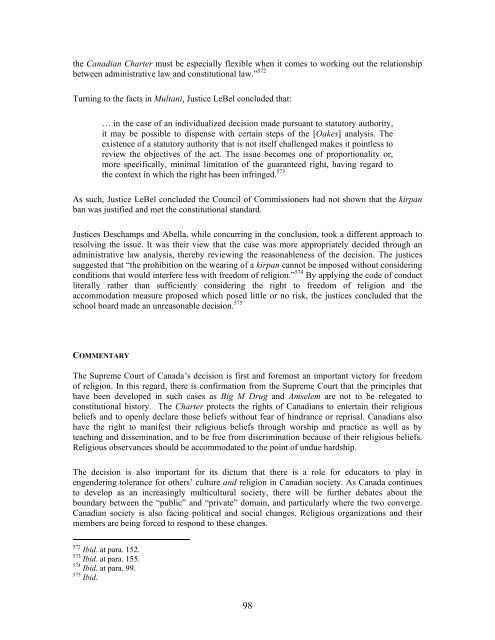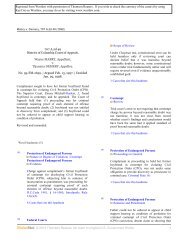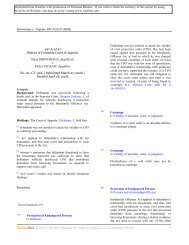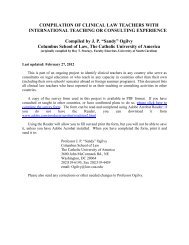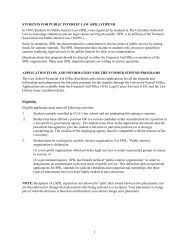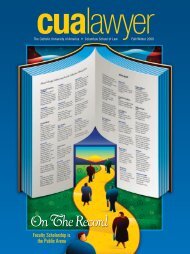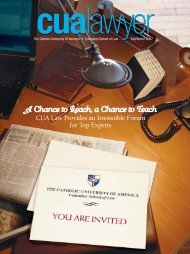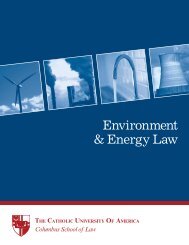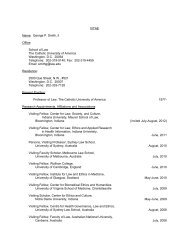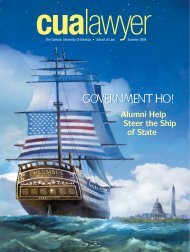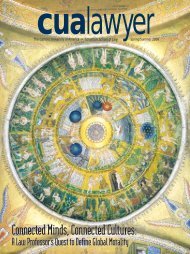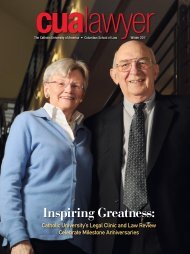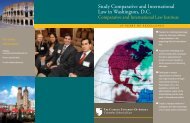Volume IV, Issue II (April 2006) - Columbus School of Law
Volume IV, Issue II (April 2006) - Columbus School of Law
Volume IV, Issue II (April 2006) - Columbus School of Law
Create successful ePaper yourself
Turn your PDF publications into a flip-book with our unique Google optimized e-Paper software.
the Canadian Charter must be especially flexible when it comes to working out the relationshipbetween administrative law and constitutional law.” 572Turning to the facts in Multani, Justice LeBel concluded that:… in the case <strong>of</strong> an individualized decision made pursuant to statutory authority,it may be possible to dispense with certain steps <strong>of</strong> the [Oakes] analysis. Theexistence <strong>of</strong> a statutory authority that is not itself challenged makes it pointless toreview the objectives <strong>of</strong> the act. The issue becomes one <strong>of</strong> proportionality or,more specifically, minimal limitation <strong>of</strong> the guaranteed right, having regard tothe context in which the right has been infringed. 573As such, Justice LeBel concluded the Council <strong>of</strong> Commissioners had not shown that the kirpanban was justified and met the constitutional standard.Justices Deschamps and Abella, while concurring in the conclusion, took a different approach toresolving the issue. It was their view that the case was more appropriately decided through anadministrative law analysis, thereby reviewing the reasonableness <strong>of</strong> the decision. The justicessuggested that “the prohibition on the wearing <strong>of</strong> a kirpan cannot be imposed without consideringconditions that would interfere less with freedom <strong>of</strong> religion.” 574 By applying the code <strong>of</strong> conductliterally rather than sufficiently considering the right to freedom <strong>of</strong> religion and theaccommodation measure proposed which posed little or no risk, the justices concluded that theschool board made an unreasonable decision. 575COMMENTARYThe Supreme Court <strong>of</strong> Canada’s decision is first and foremost an important victory for freedom<strong>of</strong> religion. In this regard, there is confirmation from the Supreme Court that the principles thathave been developed in such cases as Big M Drug and Amselem are not to be relegated toconstitutional history. The Charter protects the rights <strong>of</strong> Canadians to entertain their religiousbeliefs and to openly declare those beliefs without fear <strong>of</strong> hindrance or reprisal. Canadians alsohave the right to manifest their religious beliefs through worship and practice as well as byteaching and dissemination, and to be free from discrimination because <strong>of</strong> their religious beliefs.Religious observances should be accommodated to the point <strong>of</strong> undue hardship.The decision is also important for its dictum that there is a role for educators to play inengendering tolerance for others’ culture and religion in Canadian society. As Canada continuesto develop as an increasingly multicultural society, there will be further debates about theboundary between the “public” and “private” domain, and particularly where the two converge.Canadian society is also facing political and social changes. Religious organizations and theirmembers are being forced to respond to these changes.572 Ibid. at para. 152.573 Ibid. at para. 155.574 Ibid. at para. 99.575 Ibid.98


